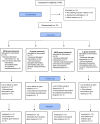The influence of myofascial release on pain and selected indicators of flat foot in adults: a controlled randomized trial
- PMID: 35082352
- PMCID: PMC8791964
- DOI: 10.1038/s41598-022-05401-w
The influence of myofascial release on pain and selected indicators of flat foot in adults: a controlled randomized trial
Abstract
Flat foot pain is a common complaint that requires therapeutic intervention. Currently, myofascial release techniques are often used in the therapy of musculoskeletal disorders. A group of 60 people suffering from flat feet with associated pain. Patients were assigned to four groups (15 people each): MF-myofascial release, E-the exercise program, MFE-myofascial release and the exercise program, C-no intervention. The rehabilitation program lasted 4 weeks. The NRS scale was used to examine pain intensity and FreeMed ground reaction force platform was used to examine selected static and dynamic foot indicators. Statistically significant pain reduction was obtained in all research. A static test of foot load distribution produced statistically significant changes only for selected indicators. In the dynamic test, statistically significant changes were observed for selected indicators, only in the groups subjected to therapeutic intervention. Most such changes were observed in the MF group. In the dynamic test which assessed the support phase of the foot, statistically significant changes were observed only for selected subphases. Most such changes were observed in the MFE group. Both exercise and exercise combined with myofascial release techniques, and especially myofascial release techniques alone, significantly reduce pain in a flat foot. This study shows a limited influence of both exercises and myofascial release techniques on selected static and dynamic indicators of a flat foot.
© 2022. The Author(s).
Conflict of interest statement
The authors declare no competing interests.
References
-
- Binek E, Olszewski J. Stopy z obniżonym wysklepieniem jako współczesny problem interdyscyplinarny. Kwart. Ortop. 2012;1:1–6.
-
- Rai D, Aggarwal L. The study of plantar pressure distribution in normal and pathological foot. Pol. J. Med. Phys. Eng. 2006;2:25–34.
Publication types
MeSH terms
LinkOut - more resources
Full Text Sources
Medical


